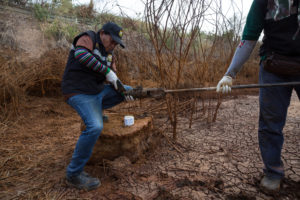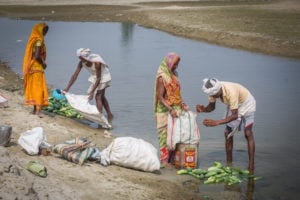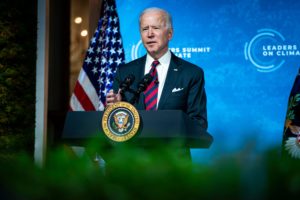In the run-up to the Leaders Summit on Climate called by Joe Biden on 22-23 April, the US president has asked Congress for USD 2.5 billion for international climate finance. This includes USD 1.2 billion for the Green Climate Fund (GCF), the body set up by the UN to help developing countries combat climate change. But activists have said the amount is “not enough” to make up for the lack of support during the Trump years. Developing countries do not seem impressed either.
During the presidency of Barack Obama, the US had promised USD 3 billion to the GCF. However, only USD 1 billion had been paid before Donald Trump withdrew his government’s support altogether. Activists are now pointing out that Biden’s promised USD 1.2 billion falls well short of the USD 2 billion the country already ‘owes’.
The World Resources Institute, a non-profit US research organisation, said Biden’s moves on finance were a good first step, but much more needs to be done. In March, 40 Democratic congressmen wrote to Biden, asking him to give USD 4 billion to the GCF this financial year: the USD 2 billion “outstanding” and an additional USD 2 billion as the first tranche of a fresh USD 6 billion pledge.
The global view: state funds needed for climate solidarity
Emerging economies feel the amount promised by Biden is inadequate, though their criticism has been levelled at all developed countries. At a virtual meeting of the BASIC (Brazil, South Africa, India, China) countries on 8 April, “Ministers expressed their deep concern on the insufficiency and inadequacy of the support provided by developed countries to date. The scale and speed of climate finance from developed countries has to increase considerably,” according to their joint statement.
When John Kerry, the US president’s special climate envoy, visited New Delhi on 8 April, he did not get an assurance that India would declare a target year by which it would become a ‘net-zero’ emitter of greenhouse gases. But the two countries agreed to jointly mobilise financing for clean energy projects and adaptation to climate change impacts.
Such assurances may be significant for emerging economies. For example, large-scale solar power took off in India a decade ago because a US Export-Import Bank guarantee enabled the initial projects to borrow money. But this is not enough for smaller developing countries, which are therefore keener on financing from governments of developed countries rather than private players.
A group of relatively small developing countries that have come together under the umbrella of ‘climate-vulnerable nations’ took on rich countries in early April at a virtual meeting hosted by the UK. Bangladesh is a leading member of the group. The group pointed out that of the little public funding available, only 20% goes to adaptation, despite this being the immediate need of developing nations. The UK government promised to take up the matter at a meeting of the G7 nations it is hosting in June.
From New Delhi, Kerry travelled to Dhaka, Bangladesh, where he spoke of already-committed financing of up to USD 17 million for clean energy projects. Other developing countries are hoping for similar or larger financial support.
Summit may resurrect debate on climate finance
So far, criticism of Biden’s financial plan has been muted beyond the activists’ corner. But it is unlikely to remain so when negotiations restart under the UN Framework Convention on Climate Change (UNFCCC) prior to and during the next UN climate summit, known as COP26, scheduled to be held in Glasgow in November 2021.
Ministers of the BASIC countries have urged developed nations to enter COP26 talks with a clear plan on how they intend to fulfil their promise to provide USD 100 billion per year, at least from 2021 to 2025. This promise dates from 2009, when then-US secretary of state Hillary Clinton pledged that developed countries would mobilise this amount each year from 2020 to help developing nations move towards green economies and adapt to the impacts of climate change. Rich nations had promised to start paying from 2010, ramping up the amount to USD 100 billion per year by 2020.
Estimates of the actual amount provided since depend on who has done the counting. The rich nations’ think-tank the Organisation for Economic Co-operation and Development said the amount rose to USD 78.9 billion in 2018, prompting accusations from developing countries of double counting, conflating loans and grants, and other forms of creative accounting. At the 2016 climate summit, a subsidiary body of the UNFCCC came up with a figure of USD 23.5 billion given by rich nations till then.
In light of these controversies, ministers at the BASIC meeting in April called for “a multilaterally agreed definition of [what constitutes] climate finance” and accounting practices to measure it.
Money in the bank
Since its inception in 2010, the GCF has financed projects worth USD 5.3 billion. The gap between the promised USD 100 billion per year and the current reality is clear for developing countries to see.
Some voice their disappointment more loudly than others, while others keep quiet lest bilateral deals go sour. But this discrepancy has seriously eroded the trust of developing countries in climate finance pledges from developed nations.
Developing countries disproportionately bear the brunt of climate change impacts, despite being the least responsible for driving climate change. They need money both to move towards a cleaner economy and to adapt to the impacts they face today.
Many developing countries have sought climate financing from the World Bank and its associates, whose joint climate investment funds (CIF) has a commitment of USD 23.49 million as of 2021. But the CIF’s accounting and administrative systems have been repeatedly criticised by developing nations as being overly complex, leading them to spend around 20% of the project money on consultants rather than the communities in whose name the money is obtained.
Seeking a solution
With the Covid-19 pandemic hitting every economy, developing countries can see they are not going to get USD 100 billion a year from governments of rich nations in the immediate future. They may not say this in public, and they may keep up the pressure on rich countries during climate negotiations, but governments are looking for alternatives.
The costs of dealing with climate impacts and moving to cleaner economies is counted in trillions of dollars. The only organisations with that kind of money are investment funds, particularly pension funds, which are among the biggest investors in global financial markets.
Many attempts have been made to get these funds to dedicate a significant portion of their investments to clean technologies and adaptation, but the results so far have been poor.
Immediately after the Paris climate summit in 2015, senior members of the French delegation formed an informal group of experts in climate finance. This group has since been talking to finance ministers, fund managers, insurance and reinsurance firms to determine what kind of guarantees would be acceptable to global investors and make clean technology and adaptation projects bankable, especially in the smaller developing countries.
Their current effort is to convince the US Exim Bank, the European Bank for Reconstruction and Development and similar organisations to stand as guarantor for projects in all developing countries, especially the smaller ones. The move towards a more climate-resilient world depends hugely on the extent of their success.









